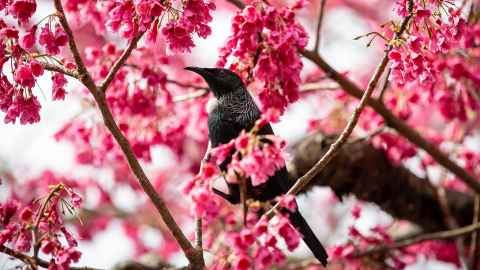A sustainable oasis of nature at the heart of the University
18 October 2022
The vision for the University of Auckland's campuses is to create a series of green oases in the midst of Aotearoa New Zealand’s largest city.

Waipapa Taumata Rau, University of Auckland grounds and precinct manager Stanley Jones has no Māori heritage, but describes his role as one of kaitiakitanga or guardian of the University’s natural environments, a role carried out by those before him and those to follow.
"All of what we do invites the birds, the bees, and creates carbon. We don't throw anything away, we’ll find a purpose for something if it dies," Stanley says.
The University's main City Campus, adjacent to Auckland’s central business district, is a conservation area comprising 41,500 square metres, containing more than 400 trees, many of which are considered 'mature' and taller than 10m.
The tallest tree, a Norfolk Pine at the eastern end of the lawns of Old Government House, stores approximately five percent of the total carbon captured for the entire conservation area.
The University benefits from this 'inner city forest' which includes trees Indigenous to Aotearoa, such as kauri, kōhūtukawa, tītoki, a seedling of Tāne Mahuta (the kauri that's the tallest and oldest tree in the country and a taonga to te ao Māori) and a healthy rimu planted by the late Queen Elizabeth II in 1953.
The trees and plantings are home to a neigbourhood of native birds, including tūī.
Stanley's kaitiakitanga practice is founded on minimising external inputs to create a sustainable biodiverse ecosystem. A sanctuary for bees sits next to the nursery where Stanley and his colleagues propagate seedlings. The team don't use pesticides or herbicides and, as the trees reach the end of their lifespan, there is an extensive mulching programme to reduce water use, suppress weeds and improve the soil.
When a centuries-old oak dies, it leaves a considerable resource. Stanley and his team make sure none of it goes to waste. As well as mulch and compost, the salvageable wood is turned into garden seating.
Stanley describes taking care of the environment as also taking care of the person. He strongly encourages visitors, students and staff to put down their phones and engage with the University gardens.
"It is good for the soul to switch off and enjoy this space which is a little more permanent than we are," he says. "Just sit under a big tree and experience it."
Media queries
Te Rina Triponel | Kaitohutohu Pāpāho Māori
E: te.rina.triponel@auckland.ac.nz